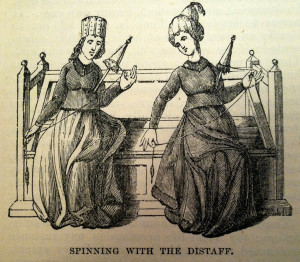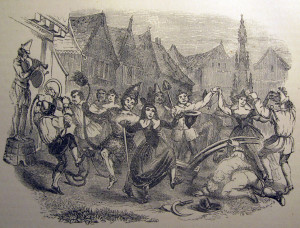With the Twelve Days of Christmas now officially past, we enter again into the workaday world. Nowadays, we tend to get back to work right after Christmas. If we are lucky, maybe we’ll be off ’til New Year’s Day. There was a time when lots of folks would be off from the major part of their labors for all of the Twelve Days of Christmas. And once they went back to work once Christmas had passed, it was done with a bit of fun and ceremony. In England, for the women, it was traditionally the 7th of January; for the men, it was the Monday following Epiphany. These two days are known as St. Distaff’s Day and Plough Monday. We’ll begin with the women and a famous poem about the day by Robert Herrick, one of our favorite convivial British poets from the 17th century. He sets the tone right from the start, with, I think, some very good advice given in those first two lines:
Saint Distaff’s Day, or the Morrow after Twelfth Day
by Robert Herrick, 1648
Partly worke and partly play
Ye must on St. Distaff’s Day:
From the Plough soone free your team;
Then come home and fother them.
If the Maides a-spinning goe,
Burne the flax, and fire the tow:
Scorch their plackets, but beware
That ye singe no maiden-haire.
Let the maides bewash the men.
Give St. Distaff all the right,
Then bid Christmas sport good night;
And next morrow, every one
To his owne vocation.
It may very well be St. Distaff’s Day––when I first came across a mention of it in 1992 or so––that is responsible for my fascination with traditional customs and old ways. It was the first two lines of the poem I knew back then, and I was so happy to run into this tradition that allowed me to hang on to some semblance of Christmas for yet another day. I’ve learnt a lot more about St. Distaff’s Day since. So, let’s explain it… and Plough Monday, as well (along with this year’s dates).
ST. DISTAFF’S DAY
January 7
The English have a long history of creating saints’ days for saints that never existed at all. St. Monday was the name given to the long weekends sometimes taken by shoemakers, and St. Tibb was often used as a metaphor for never, as in, “Hey, I lent you a shilling last week; when will I get my money back?” “Worry not, I’ll be sure to have it back to you by St. Tibb’s Day.” Which is all well and good until the lender realizes that there is no St. Tibb’s Day. Neither St. Tibb nor St. Monday ever existed; nor did St. Distaff. The distaff, however, was a central tool to what was considered in those days “Women’s Work”: the spinning of wool or flax to make fiber for weaving into cloth. The distaff and spindle were the tools that preceded the spinning wheel, and rare it would have been to find a woman who knew not how to use them. We get the word spinster from this, which was once was a recognized legal term in England to describe an unmarried woman, and the terms spear side and distaff side were also legal terms to distinguish the inheritances of male from female children.
And so the women returned to their spinning each 7th of January, this “morrow after Twelfth Day.” Meanwhile, the men were still underfoot in the house. Their job on St. Distaff’s Day was one of mischief, with the goal usually being to set fire to the flax the women were spinning. The women were wise to this custom, though, and typically kept several buckets of water nearby. Very often, it was the men who got the worst of it: to have a bucket of water dumped on you in the cold of January (that’s the “bewash the men” part)… for sure, St. Distaff’s Day lent a bit of excitement to the sport of returning to ordinary time. Meanwhile, the men had customs of their own to attend to, preparing for their day.
PLOUGH MONDAY
First Monday after Epiphany
The men got a moveable date for their traditional Back to Work day. It’s a holiday that is noted as far back as 15th century pre-Reformation England as a religious festival in which money would be raised for the parish. Plough lights would be illuminated in the churches as a way of blessing the local farmers and their fields and crops. The parish was often the home of a community plough, as well, for farmers who could not afford their own. When the Church of England broke away from Rome, this was one of many practices that were deemed “popish” and left behind, but by the late 1700s, Plough Monday began seeing a revival, with a distinct shift from its origins. In its newer incarnation, there was a lot more ale involved. There would be a ceremonial ploughing of the ground, which very often, in days of dirt roads, would be in the very road that ran through the village. The ploughs would be blessed and finely decorated, the men would parade in costume, there would be music and mummers and plays and a great hoopla of noise and all kinds of good sport. There would be a collection taken up door to door to pay for the tavern bill that came after; those who were too stingy to contribute risked having the path to their door ploughed, as well.
As for the men’s costumes, the sillier, the better, and for sure there is a bit of the Feast of Fools, which we saw during the Twelve Days of Christmas, that comes into play on Plough Monday. It is traditional for one man in each Plough Monday gathering to dress as the Bessy, an old woman who we can link firmly to pagan goddess celebrations: she is the personification of the hag, the old woman of winter who, in the seasonal round of the year, will transform come spring into the virginal young goddess… which comes only a few weeks from now, for in the traditional reckoning of time, spring will have its first stirrings with St. Brigid’s Day and Candlemas at the start of February. It is Brigid that personifies the young maid of spring. Indeed, Brigid is our bridge from winter to spring.
And so back to work, back to the workaday world. In this house we are holding on to our Christmas until Candlemas, as is our custom… but it is back to earning a living again, and earning our daily bread, and back to regular routines.
Today’s two images, like bookends on this chapter, are taken from the Chambers Bros. Book of Days, published in Edinburgh, 1869. The top one illustrates their chapter on St. Distaff’s Day; the bottom one, Plough Monday.

